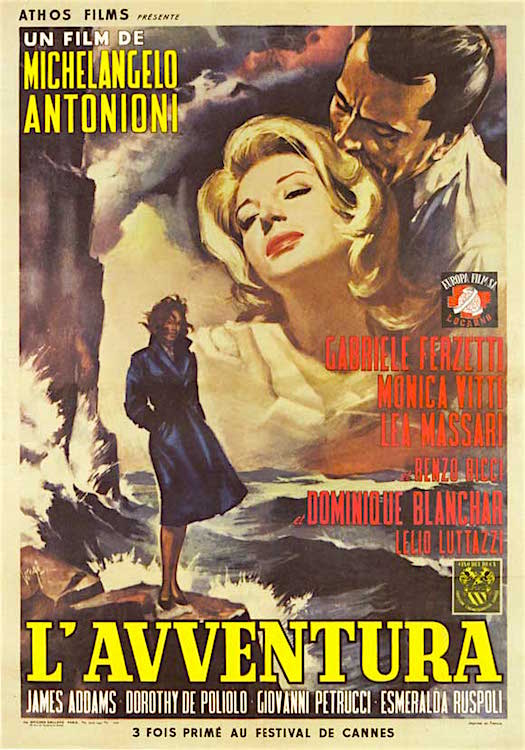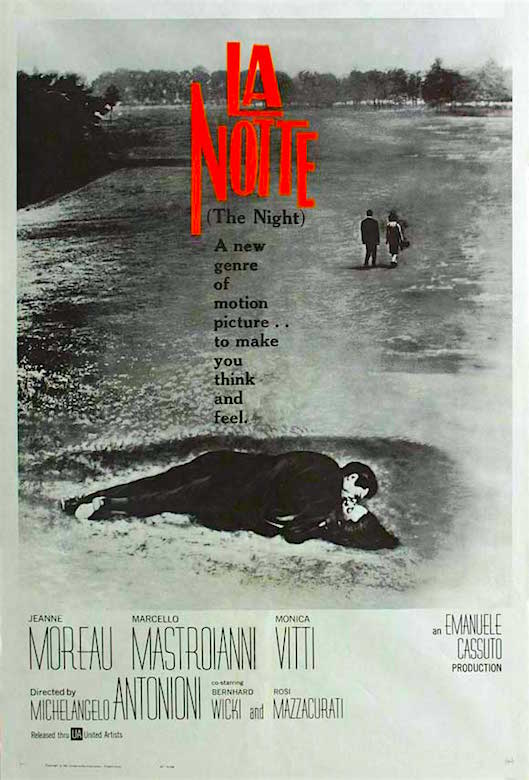“We know that behind every image revealed there is another image more faithful to reality, and in the back of that image there is another, and yet another behind the last one, and so on, up to the true image of that absolute, mysterious reality that no one will ever see.” — Michelangelo Antonioni

“Nothing like a little disaster for sorting things out.”
Blow-Up
Michelangelo Antonioni, 1966
Cinematography | Carlo Di Palma
The most important films of Michelangelo Antonioni’s career came in the early 1960’s when he placed his muse, Monica Vitti, at the core of plots involving alienation within the spacial landscapes that furthered her character’s emotional turmoil. She was the perfect actor for these roles which required an odd intermixing of passion, panic, eroticism and almost overwhelming passive boredom. Writing this description it is hard to understand how she was able to do it.
There are very few film actresses that look anything like she did. In Antonioni’s films she seems like she might fall over at any moment and yet oppositional in that she also seems capable of knocking anyone down who might get in her way. In these films, Monica Vitti is both passive and aggressively demanding. She presented a sort of quiet introspection that threatens as much as it begs. Like Antonioni’s camera she is lost within the framework of her surroundings. As his films progressed her characters seemed to be simultaneously formed, informed and destroyed by every “thing” around her.

“A new adventure in filmmaking…”
Monica Vitti contemplates.
L’Avventura
Michelangelo Antonioni, 1960
Cinematography | Aldo Scavarda
1960’s L’Aventura is entirely dependent upon Monica Vitti’s presence. Vitti has such a strongly unique erotic charisma, being and mystifying beauty and everything that happens in the film requires her to make it believable. It is impossible for the viewer to take their eyes off of her. Within only a few minutes of Claudia entering the camera’s frame, the audience is placed in a surprisingly uncomfortable position.
Is this young woman someone we can trust? Do her actions seem disconnected from her motivation?
It says a great deal that we contemplate these ideas so early on. As the film moves forward the viewer must decide if Claudia is actually concerned or simply curious. There seems to be a deception playing out within the geographical and interior spaces.
Antonioni finds ways to casually push a suspicious and possibly tragic disappearance further way from his film’s plot. What at first seems like an essential motivation for Claudia and that of her vanished friend’s lover eventually becomes nothing more than a back story. By the time the film drifts to its midpoint, the audience becomes accomplices in Claudia‘s warped journey. Like her, we no longer care longer about this missing friend, daughter and fiancee. Our primary concern becomes the possibility of love between Claudia and the “worried” fiancee. There is an ever unsettling feeling that the two leading characters hope the respective friend and lover is never found. The real kick-spin is that both have different reasons for wishing this woman to stay vanished. It is an alarming shift of gears that doesn’t really hit you until the “Fine” title card emerges on the screen.

Gabriele Ferzetti and Monica Vitti
L’Avventura
Michelangelo Antonioni, 1960
Cinematography | Aldo Scavarda

Gabriele Ferzetti and Monica Vitti
L’Avventura
Michelangelo Antonioni, 1960
Cinematography | Aldo Scavarda

Is she thinking of her friend or obsessing about herself?
Monica Vitti
L’Avventura
Michelangelo Antonioni, 1960
Cinematography | Aldo Scavarda
1961’s La Notte is less interested in telling a story than pulling the audience into a different world. The world in which we find ourselves alternates between cold and intimidating to abandoned and decaying. It seems to be in a state of change that threatens to push our characters even further into isolation. The film is an effective, textured and sensual exploration of a specific place during a specific moment in time. The time is 1961 and the place is Milan.
The modern architecture is carefully photographed and it seems to reflect, deflect and motivate the film’s characters. The schism between the ultra-modern designs and the remainders of pre-WWII Italy the audience is allowed to see seems to play roles in the way characters relate or fail to relate to one another. The old and dilapidated appear to be falling away and replaced with sleek and modern youth. The same appears to be happening to a married couple. As we follow the two halves of a near middle-age couple roam through their day and evening ideas fill both the screen and the mind.

Jeanne Moreau’s character is reduced in self-worth and hope as she wanders the streets of Milan.
La Notte
Michelangelo Antonioni, 1961
Cinematography | Gianni Di Venanzo
The ideas do not form a unified thought or purpose. Nor does the roaming lead to anywhere specific. This is the point.

Jeanne Moreau roams the mansion while Monica Vitti basks in her boredom…
La Notte
Michelangelo Antonioni, 1961
Cinematography | Gianni Di Venanzo
As the old falls away so do the walls that have protected generations from exposure are now given way to a certain transparency that forces the characters to see the truth of not only strangers but of each other. A brilliantly effective, evocative and sensual mood piece of European cinema. An ideal film for a viewer who likes to think and experience an art form.

Jeanne Moreau and Marcello Mastroianni fail to connect. Monica Vitti listens in…
La Notte
Michelangelo Antonioni, 1961
Cinematography | Gianni Di Venanzo
It is unlikely that it will appeal to those who seek out movies for story and escapism, but it is hard to imagine a more human experience. Hearts are damaged and there seems to be no comfort found in a marriage that has failed to flourish alongside the urban civilization that is only beginning to sprawl. The ideas associated with architecture mirroring its inhabitants is again pursued by Antonioni’s next film, L’Eclisse.
Michelangelo Antonioni’s vision is perhaps most strongly applied with L’Eclisse. This movie has become better every time I see it. It is framed as a love story, but the actual focus takes on a deeper perspective regarding the mixed and differing feelings between two would-be-lovers. The architecture of La Notte often fights to be a leading character. L’eclipse embraces both Monica Vitti and Alain Delon as the primary characters, but the architecture seems to emerge as a third.

Alain Delon and Monica Vitti are actually fitting into their environment, but are their emotions?
L’Eclisse
Michelangelo Antonioni, 1962
Cinematography | Gianni Di Venanzo
Post WWII Rome’s architectural conflict is very much present, however it often feels like the two human characters are informing it rather than the other way around. Gianni Di Venxnzo’s cinematography fully utilizes the Rome land/inner-scapes, but our two characters are essential elements in their mutual and respective worlds. Minimal in the way of speech, Antonioni still expertly captures two young people and a city in the midst of adapting to post-war changes.

There is a great more between these two lovers than a structural support column.
Michelangelo Antonioni, 1962
Cinematography | Gianni Di Venanzo
Nearly every emotion or concern felt is reflected back to them from the buildings, walls and all surroundings within which they are attempting to live, grow and love. It as if this “love” is wanting to return to the old world comforts. The problem facing both characters is how can they use love in a modern world that refuses to go back? If there were to be a means of escape, would they lose more if they left? An essential and magical film.

A poster seems to be offering an escape, but it could be a trap of another sort.
L’Eclisse
Michelangelo Antonioni, 1962
Cinematography | Gianni Di Venanzo
In 1964 Antonioni hired Carlo Di Palma as his cinematographer. He shot Red Desert / Il deserto rosso in color. This film is deceptively beautiful because society’s landscape and territory are no longer simply imposing and reflecting emotions. In Red Desert the man-made structural landscapes and architecture is actually attacking the film’s leading character. Monica Vitti’s Giuliana is not merely trapped within the identity and isolation imposed by her environment — she is suffering as her environment is literally attacking her. The world in which Giuliana moves is toxic.
Unforgettable and operatic in her performance as a mentally unstable wife/mother, Monica Vitti becomes a walking analogy for the environment in which she must live. Surrounded by the bleakness of destructive industrial plants and the cold interiors which have been created in the surrounding suburbs. Red Desert marks a major turn in Antonioni’s vision regarding the human condition and surrounding environments.

Monica Vitti takes a walk in a post-industrial nightmare.
Red Desert
Michelangelo Antonioni, 1964
Cinematography | Carlo Di Palma

“I dreamed I was in bed and the bed was moving. I looked down and it was on quicksand. It was sinking deeper and deeper.”
Monica Vitti
Red Desert
Michelangelo
Antonioni, 1964
Cinematography | Carlo Di Palma
The captured images are surprisingly lovely, but the meanings conveyed through them come close to post-industrial horror. In many ways this film is the most experimental the director had ever made. He is clearly in love with Vitti and renders her unique beauty in the most sensual of ways. And while this movie is obviously aimed to be societal commentary, it also features a fascinating performance. As Monica Vitti forms her character she lends the film a possibility of other meanings.
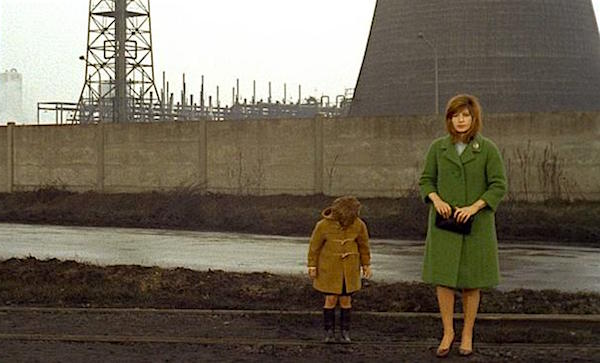
“She loved that spot. The colors of nature were so beautiful, and there was no noise. She’d leave only when the sun did too.”
Red Desert
Michelangelo Antonioni, 1964
Cinematography | Carlo Di Palma
This is realism and one is never quite sure if perhaps her challenges might be more connected to mental illness than environmental. It is easy to imagine Todd Haynes taking notes. It is hard to imagine that Red Desert did not inform his brilliant 1990’s Safe. While Red Desert is most certainly a turn in a different direction for Antonioni, his next film really swerved off his expected cinematic path.
Blow-Up finds Antonioni in a different country and films the entire film in English. This infamous 1966 film offered more than just a language and location change. Gone is the angst-ridden female protagonist. Monica Vitti is no where in sight. The new protagonist is a young man enjoying, manipulating, exploiting and indulging in the expanding excesses of Swinging London. David Hemmings plays a sly, bored and seemingly hollow fashion photographer who pursues sex and human connection with the same amount of passive interest as a random purchase at an antique store.
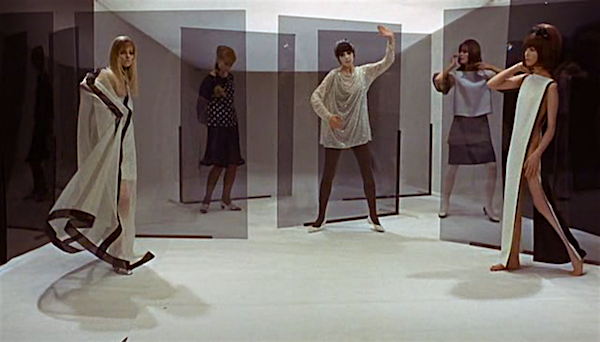
For our protagonist, models are not people. They are objects that he arranges.
Blow-Up
Michelangelo Antonioni, 1966
Cinematography | Carlo Di Palma
Not without talent, Thomas is an emerging hot talent in the world of Fashion photography. He is clearly well paid, but not yet where he wants to be. Women are no longer people to this man, they are pretty little things he photographs and seduces. Actually, he doesn’t bother with seduction. The hot young women are as hungry for fame as he is for money. People do not seem to hold much value for Thomas. Surrounded by the excitement of his city and the era in which he moves, Antonioni establishes that his protagonist is not enjoying much of anything.
It is isn’t until he makes the mistake of photographing a private moment between two lovers in a park that he is forced to actually re-evaluate his measure as a human being. Antonioni crafts a magical film. Make no mistake, he captures the ambiance of 1960’s Swinging London with the same carefully articulated method he applied to the re-emerging post-WWII Italy.
The film is slowly paced as it begins to pull the audience into the photographer’s depressingly vacuous world. But then, just as the audience thinks Blow-Up is taking in a certain direction the gears shift. Antonioni offers something that he has never given the audience before: A Hitchcockian plot twist that would have served any other filmmaker in a dramatically different way.
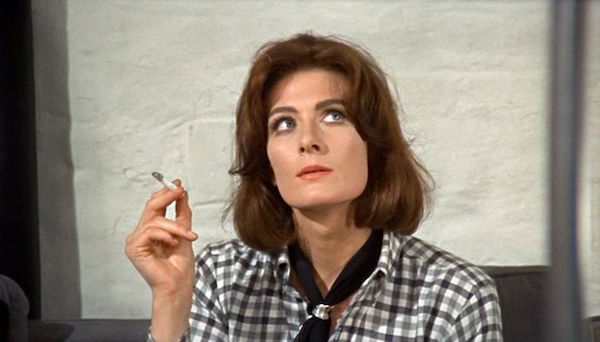
Not your typical Swinging London Party Girl, Vanessa Redgrave assess the photographer, the situation and her options.
Michelangelo Antonioni, 1966
Cinematography | Carlo Di Palma
Vanessa Redgrave’s Jane rushes into the film like a breeze of erotic curiosity and panic. Her visit to the photographer’s home and studio should lead the film in a what seems the logical place — instead this scene serves as a catalyst for introspection. As Thomas rushes through his study to blow-up the negatives of Jane‘s seemingly romantic entanglement in the park, he shows an unexpected aspect of himself. Thomas is actually interested in understanding why Jane was so desperate to secure the film he had taken of she and a lover in the park.

For the first time in the film, David Hemmings shows some passion in his pursuit of understanding.
Michelangelo Antonioni, 1966
Cinematography | Carlo Di Palma
David Hemmings’ Thomas has no connection to Monica Vitti’s Antonioni’s characters. He is not alienated. He is neither riddled with insecurity, ennui or angst of any sort. He sees something he wants, he puts forward only the required energy or money to get it. But as an artist, Thomas is curious. Of course Blow-Up wants the viewer to think it is a thriller. Once the twist is revealed, Antonioni shifts cinematic gears once more. If one must call this movie a thriller, then that person most likely needs to Anti to the term. This is one thrill that turns against the protagonist inward toward self-introspection. In some ways the cost of the plot’s thrill is far more horrifying than the stalking of a killer. Thomas soon finds himself not so much in pursuit of the answer to a mystery — he is left to contemplate the empty shell of a person he has allowed himself to become.
Less a mystery of human cruelty as it is a study humanity lost in decadence. In the end Thomas has more in common with the female protagonists of Michelangelo Antonioni’s Italian films. The only real difference is that he is male and has been allowed more access to freedom. That societally entitled power takes him no closer to fulfillment.
Matty Stanfield, 5.16.2016

